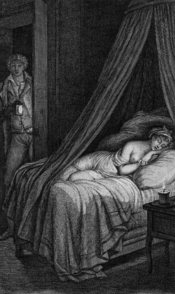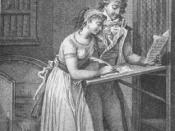Les Liaisons Dangereuses is a complex and disturbing portrayal of the noble class in pre-revolutionary France. Set in the late eighteenth century during the latter part of the Ancien Regime, Les Liaisons weaves a web of cold, calculated betrayal of the most immoral kind.
The story unfolds in the form of letters written between the principal characters, giving it a unique literary texture. By using this style, de Laclos is able to give the reader a shockingly intimate look at these people as they divulge their most intimate secrets and bring to fruition their sinister plans.
The protagonists, The Marquise de Merteuil and the Vicomte de Valmont, consider it their life's ambition to sadistically control and dominate those around them through sexual intrigue. These two villains are indeed locked in psychological combat to see who can actually 'out-do' the other in stalking, capturing and destroying the souls of others.
Taking absolute pleasure in ripping any virtue from the hearts of their prey, Merteuil and Valmont wave their accomplishments in front of each other like spoils of war. The less the chance of surrender, the more relentless is the pursuit.
The story begins with the Marquise de Merteuil corresponding with Vicomte de Valmont regarding a luscious new act of 'revenge', as she describes it, against the Comte de Gercourt. The young Cecile de Volanges has just come home from the convent and her marriage to Gercourt has been arranged. However, before he can wed the innocent child, Merteuil proposes Valmont 'educate' her, thus spoiling Gercourt's fancy for untarnished convent girls. Valmont is uninterested in such an easy seduction and is far more aroused by the thought of lulling The Presidente' de Tourvel, the very epitome of virtue, into submission. And so the tale unfolds.
Valmont eventually beds the virgin Cecile in order to humor Merteuil, however, the conquest of Madam de Tourvel is his passion and he indulges in this pursuit until he reaches the intended conclusion.
Although, it would be a mistake to depict Valmont as anything but the monster that he is, there seems to be a small measure of actual 'affection' for Tourvel, however short-lived. Once Valmont shares this strange and unexpected interest in Madame de Tourvel, The Marquise de Merteuil is enraged, considering it an appalling sign of weakness. In order to save face, Valmont returns to his ruthless ways, thus completing the destruction of Madame de Tourvel, who had ultimately fallen madly in love with Valmont.
I suggest Merteuil's bitter reaction was a result of the obvious sexual tension that exists between herself and Valmont. Although, these individuals seem not capable of such emotion, it is almost out of jealousy that she lashes out over Madame de Tourvel.
Valmont ultimately meets his end in a ludicrously honorable fashion when he engages in a dual with Chevalier Danceny, consequential of his exploits with the young Cecile. The Marquise de Merteuil, on the other hand, falls prey to a hideous, disfiguring disease, which seems a bit more fitting of her crimes.
Perhaps the most astonishing aspect of Les Liaisons Dangereuses is the fact that it does not follow the time- honored formula that 'good will eventually overcome evil'. Indeed, one is hard-pressed to find any real virtue in this book. In Les Liaisons, de Laclos speaks to a time where evil truly reined supreme.
Les Liaisons by no means encompasses the 'whole picture' of the times, however, it does depict quite explicitly the lives of a handful of aristocrats in an all too likely posture. It is well known that this Second Estate of France was exorbitantly wealthy, pampered and idle. Consequently, in order to give meaning to their boring lives, they conjured acts of increasingly questionable content, lacking in morals and conscious.
These privileged creatures of France possessed the vast majority of wealth and committed the most scandalous of acts against both their piers and those of lower social standing. It is little wonder a revolution was on the horizon.
Even though Les Liaisons Dangereuses sold out within days of the initial publication in Paris (1782), it was considered a most abominable piece of trash and created an incredible uproar. De Laclos shocked his readers to new heights of intrigue and disgust. At one point, the French government actually banned the book. However, it continued to be read and discussed, and has thus endured as a most disturbing portrait of eighteenth century nobility.





